Motor Coach Industries
Motor Coach Industries (MCI) is a multinational bus manufacturer, specializing in production of motorcoaches. Best known for coaches produced for intercity transit and commuter buses, MCI produces coaches for a variety of applications, ranging from tour buses to prison buses.
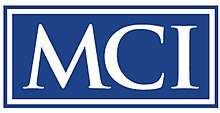 | |
| Subsidiary | |
| Industry | Transportation |
| Founded | 1933 |
| Headquarters | Des Plaines, Illinois |
| Products | Buses and Coaches |
Number of employees | 2,300 |
| Parent | NFI Group |
| Website | mcicoach |
Currently, MCI is headquartered in Des Plaines, Illinois. Since 2015, it has been a subsidiary of Canadian bus manufacturer New Flyer (part of the NFI Group).
History
The company was incorporated in 1933 as Fort Garry Motor Body and Paint Works Limited, in Winnipeg, Manitoba, Canada by Harry Zoltok.[1] In 1948, Greyhound Lines of Canada, at that time MCI's major customer, became a majority shareholder when it purchased 65% of the company. MCI was purchased outright by Greyhound Lines in 1958. In 1963 a new plant was opened in Pembina, North Dakota to increase capacity as MCI began to expand into the U.S. market, while Greyhound widened its operations and switched increasingly from GMC to its own in-house products. In 1974 another plant was opened in Roswell, New Mexico under the title Transportation Manufacturing Corporation (TMC).
In December 1986, Greyhound was split, with Greyhound Lines being sold to an investor group, and Greyhound Lines of Canada, MCI and TMC remaining part of The Greyhound Corporation, which was renamed Dial, Inc. in 1991.
In 1987, Greyhound Corporation bought the transit bus manufacturing operations of General Motors Diesel Division (GMC), which was based in Canada. (GM phased out intercity and transit bus construction at the large GMC Coach and Truck plant in Pontiac, Michigan, shifting medium duty school bus chassis production to Janesville, Wisconsin.)
MCI also took over production of GM's RTS model, transferring production to TMC. MCI also purchased the GM bus assembly plant in Saint-Eustache, Quebec, which then produced GM's Canadian transit bus model, the Classic. TMC ceased production of the older MCI vehicles in 1990 to concentrate on manufacturing the RTS, and on the "A-Model" intercity coaches.
In 1993 MCI became an independent corporation, Motor Coach Industries International Inc.
1994 acquisition
In 1994, MCI stocks were purchased by Mexican DINA S.A.,[2][3] which had a long history of bus building and developed their HTQ proprietary technology[4][5][6] (valued in a total of 70 million dollars)[7] that culminated with the creation of the Viaggio Confort Bus Line. Over the course of the next years MCI reproduced its Viaggio 1000 DOT for sale to the U.S and Canada. In late 1999/2000 the G4100, G4500 and F3500 models were released to the U.S. and Canadian markets. Production of the G4500 later moved to Winnipeg, after the G4100 had been discontinued. Poor reliability of the G4500 resulted in very low sales after Greyhound Lines filed a lawsuit against MCI over the various issues involving the bus. Greyhound took delivery of very few Winnipeg-built G4500s; these were later retired and sold. Related to a major contract cancellation[8] by Western Star,[9] DINA S.A. sold a great portion of its previously acquired MCI shares to Joseph Littlejohn & Levy.[10]
In 1994 TMC, including production rights for the RTS, was sold to NovaBus. In 1997 MCI purchased the rights from the bankrupt Flxible to produce the Flxible Metro and all related parts for same. After a period of waning product demand, increased competition and lay-offs in the early 2000s, production at MCI plants in Winnipeg and Pembina increased in 2006, and 130 employees were added.
During the late 1990s and early 2000s, MCI consolidated its operations, the Winnipeg site was expanded and modernized. DINA S.A. purchased North American Symix[11] and opened an assembly plant[7] in Buenos Aires, Argentina[12] and the DIMEX[13] and DINAIR companies.[14] A new coach finishing and paint facility and customer delivery centre were constructed on the site. At the same time, a seven-year contract was attained with the IAMAW union local. This agreement contained cost improvements and production operations flexibility to improve the productivity and competitiveness of the manufacturing and assembly operations.
The buses, especially the older MC-8 and workhorse MC-9 models of the 1980s, became the standard for interstate travel for many bus companies. Those particular buses featured metal frames and roof supports, metal panels on the sides and were extremely durable and reliable. Many of the buses, having survived millions of miles of commercial use, have been given a second career serving churches or other organizations, while the MCI/TMC coaches are very popular "conversion shells", used for motorhomes.
Currently, the "J" and "D" models are the leading coaches in the North American intercity coach market.
2008 bankruptcy
Motor Coach Industries Inc. announced on September 15, 2008, the company had filed for Chapter 11 bankruptcy protection as part of a restructuring the company said would "help shed hundreds of millions of dollars of debt".[15]
On April 17, 2009, Motor Coach Industries Inc. emerged from its voluntary Chapter 11 reorganization. MCII and its subsidiaries became wholly owned by KPS Capital Partners, LP. KPS Capital Partners, LP is the Manager of the KPS Special Situations Funds, a family of private equity limited partnerships with over $2.6 billion of committed capital focused on constructive investing in restructurings, turnarounds, and other special situations.[16][17]
Partnership with Daimler AG
Motor Coach Industries announced on April 25, 2012 that it had reached a deal with German vehicle manufacturer Daimler AG to distribute its Setra brand of motorcoaches for the North American market. The agreement came as Daimler reconfigured its commercial bus operations in North America, also selling off its Orion brand of transit buses to New Flyer Industries.
Under the agreement, Setra would build its S407 and S417 motorcoaches in Germany and ship them to North America, where MCI would sell and service the coaches using its existing dealer network. In exchange, Daimler would purchase a 10% share in Motor Coach Industries.
The relationship between competitors was less than ideal. Daimler complained that MCI focused on its own motorcoaches, and did not allow for sufficient attention to the Setra brand.[18]
The deal came to an end on January 4, 2018, with Daimler signing a new distribution rights agreement with REV Group, a US-based specialty vehicle manufacturer. Sales of new motorcoaches transferred immediately, followed by the service agreement in mid-2018.[19]
Operating subsidiaries
- Motor Coach Industries, Ltd. – Canadian manufacturing facility, located in Winnipeg, Manitoba.
- Motor Coach Industries, Inc. – U.S. manufacturing facility, located in Pembina, North Dakota.
- MCI Sales and Service, Inc. – U.S. new and pre-owned coach sales division.
- MCI Service Parts – aftermarket parts sales division of the company, based in Des Plaines, Illinois, with its distribution center located in Louisville, Kentucky, with close access to the international UPS distribution center.
- MCI Financial Services – coach financing division, based in Dallas, Texas.
Models
After the original numbered Courier and MC models, MCI adopted letters for the different series of coaches. Two different schemes have been used:
1985–2001
| Width | Series | Option | Axles | Body |
|---|---|---|---|---|
| 96 = 96 inches (2.4 m) 102 = 102 inches (2.6 m) |
A B C D E |
L = 45 ft 7 in (13.89 m) length
W = wheelchair lift-equipped
|
2 3 |
none = aluminum
SS = stainless steel
|
| Example: 102-DL3SS | ||||
2001–present
| Series | Length | Version | Options (D series only) | |
|---|---|---|---|---|
| D E F G J |
35 = 35 ft 5.5 in (10.81 m) 40 = 40 ft 6 in (12.34 m) 41 = 41 ft 7 in (12.67 m) 45 = 45 feet 7 inches (13.89 m) |
00 = 1st 05 = 2nd |
CL = "classic" styling CT = "contemporary" styling (diesel/CNG) CTH = "contemporary" styling (hybrid-electric) ISTV = inmate security transportation vehicle N = 96-inch (2.4 m) narrow body | |
| Example: D4500CT | ||||
Current
Motor Coach Industries currently produces three different product lines. All current models are 102 inches (2.59 m) wide, exclusive of mirrors.
| Model | Photo | Height | Length | Notes |
|---|---|---|---|---|
| D40 series D4005 D4000CL D4000CT D4000CTH D4000ISTV |
 D4000CT |
11 ft 5 in (3.48 m) | 40 ft 6 in (12.34 m) |
|
| D45 series D4505 D4500CL D4500CT D4500CTH D45 CRT LE D45 CRTe LE |
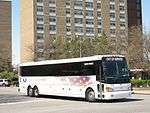 D4500CT |
11 ft 5 in (3.48 m) | 45 ft 5 in (13.84 m) | |
| J35 series J3500 |
11.73 ft (3.58 m) | 35.58 ft (10.84 m) | ||
| J45 series J4500 J4500e |
11.73 ft (3.58 m) | 45.58 ft (13.89 m) |
|
Past
Letter series (post-1985)
| Model | Height | Length | Width | Photo | Introduced | Discontinued |
|---|---|---|---|---|---|---|
| Notes | ||||||
| A series 96A2 96A3 102A2 102A3 102AW3 |
11 ft (3.35 m) | 40 ft (12.19 m) | 96 in (2.44 m) or 102 in (2.59 m) |
 |
1985 | 1991 |
| ||||||
| B series 96B3 102B3 |
11 ft (3.35 m) | 40 ft (12.19 m) | 96 in (2.44 m) or 102 in (2.59 m) |
1991 | 1993 (102B3) 1994 (96B3) | |
| ||||||
| C series 102C3 |
11 ft 6 in (3.51 m) or 11 ft 9 in (3.58 m) |
40 ft (12.19 m) | 102 in (2.59 m) | 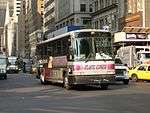 |
1988 | 1993 |
| ||||||
| D series 102D3 102DL3 |
11 ft 5 in (3.48 m) | 40 ft 6 in (12.34 m) or 45 ft 7 in (13.89 m) |
102 in (2.59 m) | 1993 | 2001 | |
| ||||||
| D series narrow D4000N |
11 ft 5 in (3.48 m) | 40 ft 6 in (12.34 m) | 96 in (2.44 m) | 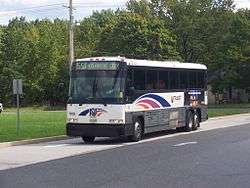 |
2002 | 2004 |
| ||||||
| E series 102EL3 E4500 E4500LX |
11 ft (3.35 m) | 45.58 ft (13.89 m) | 102 in (2.59 m) | 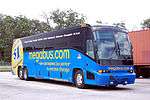 |
1998 | 2013 |
| ||||||
| F series F3500 |
11 ft 1 in (3.38 m) | 35 ft 5.5 in (10.81 m) | 102 in (2.59 m) | 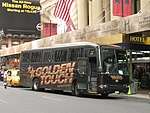 |
2000 | 2003 |
| ||||||
| G series G4100 G4500 |
11 ft 6 in (3.51 m) | 41 ft 7 in (12.67 m) or 45 ft 7 in (13.89 m) |
102 in (2.59 m) |  |
1998 (G4100) 2000 (G4500) |
2001 (G4100) 2005 (G4500) |
| ||||||
MC series (1958–1998)
These models bore the MC-number designation.
| Model | Height | Length | Width | Photo | Introduced | Discontinued |
|---|---|---|---|---|---|---|
| Notes | ||||||
| MC-1 / MCX-1 | 10 ft (3.05 m) | 35 ft (10.67 m) | 96 in (2.44 m) | 1958 | 1961 | |
| ||||||
| MC-2 / MCX-2 | 10 ft (3.05 m) | 35 ft (10.67 m) | 96 in (2.44 m) | 1960 | 1961 | |
| ||||||
| MC-3 / MCX-3 | 10 ft (3.05 m) | 35 ft (10.67 m) | 96 in (2.44 m) | 1961 | 1963 | |
| ||||||
| MC-4 | 10 ft (3.05 m) | 35 ft (10.67 m) | 96 in (2.44 m) | 1962 | 1964 | |
| MC-5 / MCC-5 / MCX-5 | 10 ft (3.05 m) | 35 ft (10.67 m) | 96 in (2.44 m) | 1963 | 1965 | |
| ||||||
| MC-5A / MCC-5A | 10 ft (3.05 m) | 35 ft (10.67 m) | 96 in (2.44 m) | 1964 | 1970 | |
| ||||||
| MC-5B | 10 ft (3.05 m) | 35 ft (10.67 m) | 96 in (2.44 m) | 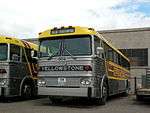 |
1971 | 1977 |
| ||||||
| MC-5C | 10 ft (3.05 m) | 35 ft (10.67 m) | 96 in (2.44 m) | 1977 | 1980 | |
| ||||||
| MC-6 / MCX-6[22] | 12 ft (3.66 m) | 40 ft (12.19 m) | 102 in (2.59 m) | 1969 | 1970 | |
| ||||||
| MC-7 | 10.83 ft (3.30 m) | 40 ft (12.19 m) | 96 in (2.44 m) | 1968 | 1973 | |
| ||||||
| MC-8 | 10.83 ft (3.30 m) | 40 ft (12.19 m) | 96 in (2.44 m) |  |
1973 | 1978 |
| ||||||
| MC-9 | 11 ft (3.35 m) | 40 ft (12.19 m) | 96 in (2.44 m) | 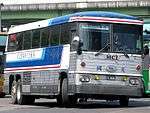 |
1978 | 1991 |
| ||||||
| MC-12 | 11 ft (3.35 m) | 40 ft (12.19 m) | 96 in (2.44 m) | 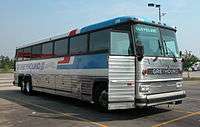 |
1991 | 1998 |
| ||||||
Courier series (pre-1960)
| Model | Length | Image | Photo | Introduced | Discontinued | Notes |
|---|---|---|---|---|---|---|
| Courier 200B | 1948 | 1950 | ||||
| Courier 200A | 1948 | 1949 | ||||
| Courier 200 | 1947 | 1948 | ||||
| Courier 100C | 1948 | 1950 | ||||
| Courier 100B | 1948 | 1949 | ||||
| Courier 100A | 1947 | 1948 | ||||
| Courier 100 | 1946 | 1947 | ||||
| Courier 97 | 1955 | 1957 | Only one built in December as Western Canada Greyhound Lines number W960. | |||
| Courier 96 | 1955 | 1960 | ||||
| Courier 95D | 1953 | 1960 | Diesel. | |||
| Courier 95 Courier 95 Skyview |
.jpg) |
1953 | 1960 | |||
| Courier 90 Courier 90 Skyview |
1953 | 1960 | ||||
| Courier 85X | 1951 | 1953 | ||||
| Courier 85A | 1951 | 1952 | ||||
| Courier 85 | 1950 | 1952 | ||||
| Courier 50 Courier 50A | 1950 | 1955 |
Transit (all discontinued)
| Model | Length | Width | Photo | Notes |
|---|---|---|---|---|
| TC40-102A TC40‑102N Classic |
40 ft (12.19 m) | 102 in (2.59 m) |  |
|
| TC60-102N Classic (articulated) |
60 ft (18.29 m) | 102 in (2.59 m) | 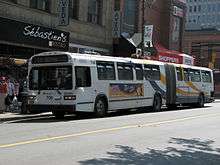 |
|
| TMC RTS-06 or -08 |
30 ft (9.14 m) or 35 ft (10.67 m) or 40 ft (12.19 m) |
96 in (2.44 m) or 102 in (2.59 m) |
  |
|
| 40TRY |
| |||
| 150 |
|
See also

References
- History of Motor Coach Industries. Mcicoach.com. Retrieved on October 17, 2011.
- Company News; Boards Approve Grupo Dina-Motor Coach Merger. The New York Times (May 19, 1994). Retrieved on October 17, 2011.
- HighBeam
- Industry Today – The World of Manufacturing Archived July 17, 2011, at the Wayback Machine. Usitoday.com. Retrieved on October 17, 2011.
- Grupo Dina Unveils Its HTQ Series. Theautochannel.com. Retrieved on October 17, 2011.
- Grupo Dina Unveils Its HTQ Series Launching a New Era in Global Truck Technology | Business Wire. Find Articles (September 24, 1998). Retrieved on October 17, 2011.
- History Archived May 13, 2011, at the Wayback Machine. Dina.com.mx. Retrieved on October 17, 2011.
- INTERNATIONAL BUSINESS; Mexican Truck Maker May Lose Order. The New York Times (September 28, 2000). Retrieved on October 17, 2011.
- Union Postpones Strike at Grupo Dina Plant. Theautochannel.com. Retrieved on October 17, 2011.
- COMPANY NEWS; GRUPO DINA PLANS TO SELL 61% STAKE IN MOTOR COACH UNIT. The New York Times (June 16, 1999). Retrieved on October 17, 2011.
- MARKET-LEADING MOTOR COACH & TRUCK MANUFACTURER EXPANDS SYMIX SOFTWARE ACROSS 11-SITE OPERATION. – Free Online Library. Thefreelibrary.com (October 19, 1998). Retrieved on October 17, 2011.
- Presentó Grupo Dina sus Camiones HTQ en Argentina Archived May 14, 2011, at the Wayback Machine. Truckinginfo.com. Retrieved on October 17, 2011.
- "Quill Coupons: Get $25 off w/May 2018 Promo Codes". Find Coupon Code, Discount Code and Promo Code. Archived from the original on February 2, 2011. Retrieved February 20, 2011.
- DINA S.A. Maquinas de Compresion de Gases. Compresoresdina.com. Retrieved on October 17, 2011.
- MacPherson, James. Motor Coach files for bankruptcy protection, Grand Forks Herald, September 15, 2008. Accessed September 17, 2008.
- Motor Coach Industries Emerges from Chapter 11 Archived February 29, 2012, at the Wayback Machine. Pr-inside.com. Retrieved on October 17, 2011.
- KPS Capital Partners, LP. Kpsfund.com. Retrieved on October 17, 2011.
- "MCI to cease distributing Daimler's Setra coaches". www.metro-magazine.com. January 4, 2018. Retrieved December 23, 2019.
- "MCI To Cease Distributing Daimler's Setra Coaches". mcicoach.com. Archived from the original on March 10, 2018. Retrieved March 9, 2018.
- "New Flyer buys Motor Coach Industries for $604M Cdn". www.cbc.ca. Retrieved November 10, 2015.
- "MCI Models A-J National Bus Trader" (PDF). Archived from the original (PDF) on October 6, 2014. Retrieved November 20, 2014.
- Plachno, Larry (March 1981). "MCI MC-6: The bus that wanted to be Scenicruiser". National Bus Trader. National Bus Trader, Inc.: 12–31.
- "MCI Celebrates 80 Years of Bus Production - National Bus Trader". busmag.com. Retrieved October 15, 2018.